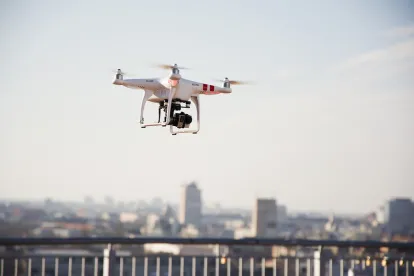On Tuesday, June 21, 2016, the Federal Aviation Administration (“FAA”) finalized its long-awaited rule on the commercial use of small unmanned aircraft systems (“UAS” or “drones”). The rule is significant because it provides a comprehensive and generally applicable set of rules for anyone wishing to operate a small drone for commercial purposes.
Before the adoption of this rule, which will take effect in August 2016, anyone wishing to operate a drone for anything other than hobbyist recreation had to apply for an individualized authorization from the FAA. Although the FAA had made an effort to process the authorizations quickly, the applications quickly developed a backlog. We expect that the new rule, which applies to drones weighing less than 55 pounds, will spur widespread use of drones for a variety of commercial operations, including aerial video for newsgathering, pipeline and radio tower inspections, aerial surveying, aerial photography for real estate and construction site monitoring, disaster response, and other uses still to be developed.
The rule includes several major new developments, including the following:
-
A new type of pilot’s license. A traditional aircraft pilot’s license will no longer be required to operate a drone for commercial purposes. The rule creates a new type of pilot’s license—called a Remote Pilot Certificate—which will be much easier to obtain. Applicants must be at least 16 years old and proficient in English, pass an Initial Aeronautical Knowledge Test at an FAA-approved test center, and pass a TSA background check. Unlike a traditional pilot’s license, the Remote Pilot Certificate does not require the individual to obtain a medical certificate, pass a vision test, or demonstrate any flight proficiency, which significantly reduces the burden on obtaining the license. The FAA estimates the application process will take six to eight weeks to complete.
-
Operational restrictions and the ability to seek waivers. The rule imposes a variety of operational limits similar to those imposed under the current Section 333 exemption process. Flights must occur below 400 feet and at speeds less than 100 miles per hour. The drone must remain within the visual line of sight of either the pilot or a visual observer (without the aid of binoculars, etc.). Flights must occur during daylight hours. Drones may not fly over individuals who are not involved in the operation or under a covered structure. Interestingly, the FAA provided that most of these restrictions can be waived if the applicant demonstrates that operation can still be safely conducted. The FAA will be establishing a new online portal for the submission of waiver requests, and the agency estimates that waivers will be acted upon within 90 days.
-
If a waiver is requested, the application must contain a complete description of the proposed operation and a justification, including supporting data and documentation (as necessary), that establishes that the proposed operation can be conducted safely. The time required for the FAA to make a determination regarding waiver requests will vary based on the complexity of the request. The amount of data and analysis required as part of the application will be proportional to the specific relief that is requested. For example, a request to waive several parts of the rule for an operation that takes place in a congested metropolitan area with heavy air traffic will likely require significantly more data and analysis than a request to waive a single section for an operation that takes place in a sparsely-populated area with minimal air traffic. If a waiver is granted, FAA may require specific special provisions designed to ensure that the UAS operation will be conducted as safely as one conducted without a waiver.
-
-
Transportation of property for compensation. The new rule provides a relatively limited authorization for commercial drones to transport property for compensation. Notably, the flight must occur within the bounds of one state and the flight must be conducted within the visual line of sight of the remote pilot in command or of a visual observer. The FAA notes that the visual line of sight requirement for this authorization cannot be waived. Although this authorization is unlikely to satisfy those seeking to deliver products by autonomous drones, this limited authorization may provide a path for further development of these types of technologies.
-
Authority to operate in various airspaces. The new rule generally provides a blanket authorization for the operation of commercial drones in Class G airspace, which is generally the low altitude airspace far from any airport. To operate in any controlled airspace (Class B, C, D, and E), an operator must seek prior permission from Air Traffic Control. Notably, the FAA is creating a new online web portal through which operators will request such permission. The FAA stated that all requests must be made through the portal; an operator cannot simply contact a local control tower for authorization. It is not yet clear whether such requests will be granted expeditiously. Significant portions of major cities have controlled airspace that extends all the way to the ground. The requirement for prior authorization could hamper the use of drones in these areas when rapid deployment is essential, such as for newsgathering.
Those who received exemptions under Section 333 do not need to re-apply for any waivers they may have under the new rule. All existing Section 333 exemptions are still in effect, and after the rules come into effect, operators will be able to choose whether to fly under their current exemption or to fly under the new rule. The FAA will contact parties with pending Section 333 petitions in the coming weeks regarding the status of those petitions.






 />i
/>i
